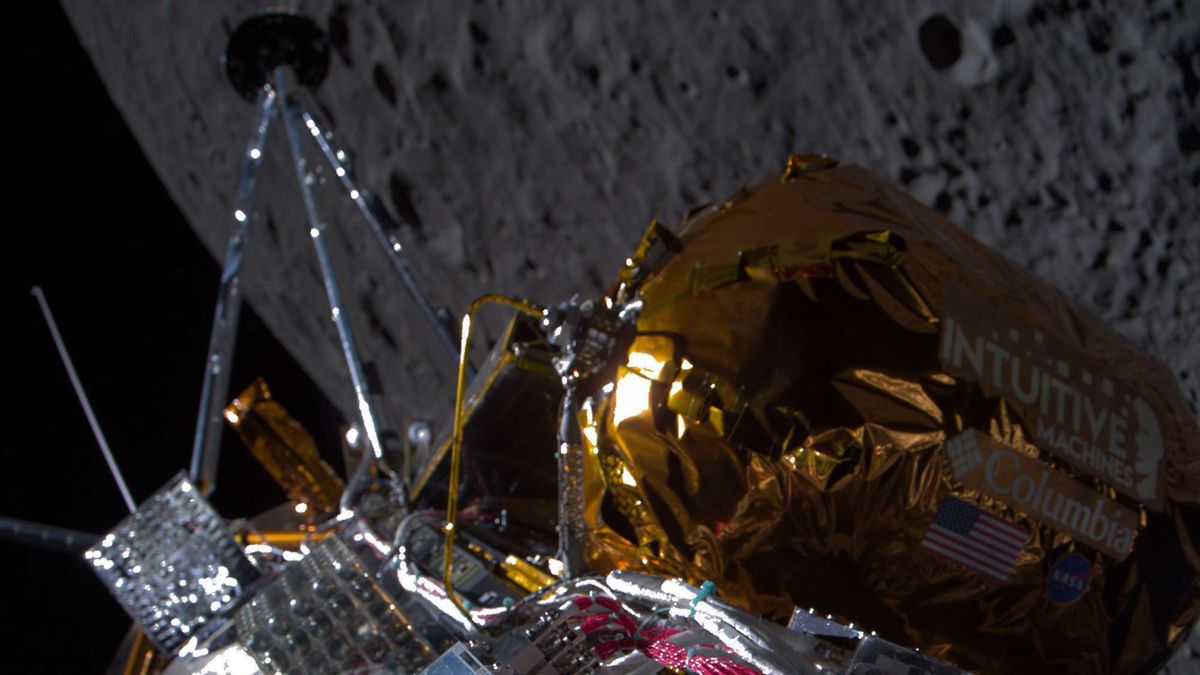The James Webb Space Telescope’s infrared vision has transformed our view of a large, barred spiral galaxy, revealing its skeleton of dust illuminated by the glow of young stars. Visible-light images of NGC 1559, such as those taken by the Hubble Space Telescope, show a glowing whirlpool of light with bright, young star clusters scattered across spiral arms laced with lanes of black dust. The JWST has now peered past the glare, its infrared vision revealing the galaxy’s innards. The JWST’s Near-Infrared Camera (NIRCam) sees starlight filtered through the obscuring…
Read MoreCategory: Solar System
Our solar system
NASA radar images show stadium-sized asteroid tumbling by Earth during flyby (photos)
A stadium-sized asteroid tumbled harmlessly past Earth this month as a powerful NASA radar system watched. Asteroid 2008 OS7 passed by Earth on Feb. 2, 2024 at a safe distance of 1.8 million miles (2.9 million kilometers), about 7.5 times farther than the Earth-moon distance. While there was no risk of the space rock harming our planet, scientists with NASA’s Jet Propulsion Laboratory (JPL) used the sophisticated Goldstone Solar System Radar (GSSR) to produce a series of images of the asteroid as it passed by us. The new observations helped…
Read MoreApollo astronaut’s granddaughter opens immersive ‘Lunar Light’ moonwalk experience in Dallas
What do you get when you mix an Apollo astronaut’s legacy with a trio of shipping containers, the latest in VR technology, the cousin of a “Star Wars” robot and an escape room like no other? Well, if you are Danielle Roosa, the answer is clear: An immersive experience that can give anyone (10 years of age or older) the chance to explore the moon. Launching on Leap Day (Feb. 29) in Dallas, Texas, “The Lunar Light: Discovery” is the creation of Roosa’s “Back to Space,” a transmedia organization that…
Read MorePut on your eclipse glasses and look up to see the biggest sunspot in years before it disappears from view
A giant sunspot continued to break records this week and is currently visible to the unaided eye with solar eclipse glasses. Between Saturday (Feb. 24) and Monday (Feb. 26), as the sunspot known as AR3590 turned toward Earth, it also grew by around 25% to become the largest sunspot of the current 11-year solar cycle, solar cycle 25, measuring around 9.5 times the surface area of Earth. NASA says that while it is never safe to look directly at the sun with unprotected eyes, eclipse glasses are perfect for observing…
Read MoreIntuitive Machines’ historic moon landing builds momentum for Artemis, astronaut Tracy C. Dyson says (exclusive)
NASA sees an even brighter future for its human moon-landing program after a private robotic mission safely touched down last week. Astronaut Tracy C. Dyson says NASA‘s Artemis program, which aims to put boots on the moon as soon as 2026, is getting “momentum” from the private Intuitive Machines landing. That mission, known as IM-1, made the first soft U.S. lunar touchdown in 52 years this past Thursday (Feb. 22). “It means we can do it,” Dyson told Space.com Monday (Feb. 26) in an exclusive interview before she returns to…
Read MorePresident Biden congratulates Intuitive Machines on historic moon landing
The company that pulled off the first American moon landing in more than half a century just got a shout-out from the country’s commander in chief. U.S. President Joe Biden congratulated Intuitive Machines on the historic touchdown of its Odysseus moon lander, which occurred on Thursday (Feb. 22) near the lunar south pole. The landing was “a thrilling step forward in a new era of space exploration,” Biden said in a statement released by the White House on Saturday (Feb. 24). “I congratulate the Intuitive Machines team who successfully landed Odysseus,…
Read MoreIngenuity Mars helicopter snapped rotor blade during hard landing last month (video, photo)
There’s no way Ingenuity could fly through this. Ingenuity, the 4-pound (1.8 kilograms) helicopter that journeyed to Mars with NASA’s Perseverance rover, was grounded for good after suffering a hard landing during a Jan. 18 flight. New observations by Perseverance show just how rough that touchdown was and make it easy to understand why Ingenuity is now a frozen feature of the Martian landscape. Related: NASA to ‘wiggle’ broken Ingenuity Mars helicopter’s blades to analyze damage Zoomed-in view of NASA’s Mars Ingenuity helicopter, captured by the SuperCam remote imager aboard…
Read MoreISS astronauts witness ‘spectacular’ auroras from space (photos)
Fresh aurora pictures from a NASA astronaut is making us green with envy. Earlier this month, International Space Station astronaut Jasmin Moghbeli captured absolutely stunning pictures of a flag-like green aurora stretching from the southern regions of the Earth far up into space. “The auroras from up here are spectacular,” NASA‘s Moghbeli told Space.com during a Wednesday (Feb. 21) ISS press conference about science. Of the green auroras Moghbeli saw on Feb. 15, she said it was one of her space mission highlights witnessing “some green, some red that just…
Read MoreJames Webb telescope finds ancient galaxy larger than our Milky Way, and it’s threatening to upend cosmology
The James Webb Space Telescope (JWST) has found a galaxy in the early universe that’s so massive, it shouldn’t exist, posing a “significant challenge” to the standard model of cosmology, according to the study authors. The galaxy, called ZF-UDS-7329, contains more stars than the Milky Way, despite having formed only 800 million years into the universe’s 13.8 billion-year life span. This means they were somehow born without dark matter seeding their formation, contrary to what the standard model of galaxy formation suggests. How this could have happened is unclear, but…
Read More‘A wonderful spectacle’: Photographer snaps rare solar eruption as ‘magnetic noose’ strangles the sun’s south pole
A gigantic plume of plasma recently exploded from the sun’s south pole, where solar eruptions almost never occur. The explosion, which a photographer captured in stunning detail, is another telltale sign that the sun is about to enter its most active phase — the solar maximum. The rare phenomenon occurred on Feb. 17, when a solar flare exploded from a sunspot near the sun’s south pole, releasing a gigantic column of ionized gas, or plasma, that towered around 124,300 miles (200,000 kilometers) above the solar surface — around 15 times…
Read More
